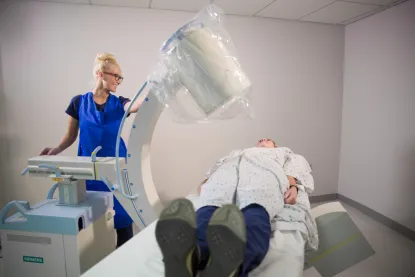
Program Overview
NMU radiography program offers a learning opportunity in the radiologic sciences; which allows a graduate the ability to prosper as a professional entry-level radiographer or seek further advancement through the diverse opportunities in diagnostic imaging. The radiography program is a five-semester, consecutive 21-month program divided into theory and clinical practicum components.
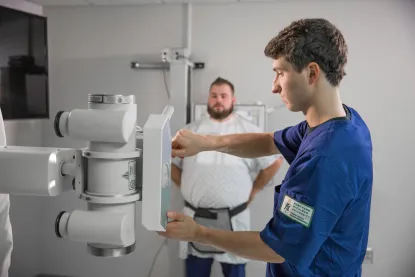
Program Curriculum
Northern Michigan University’s radiography program results in an Associate of Applied Science degree. The program consists of 89 total credits with 12 in liberal studies, 18 required non-core courses (mostly science and math courses) and 59 credits for courses in the radiography core.
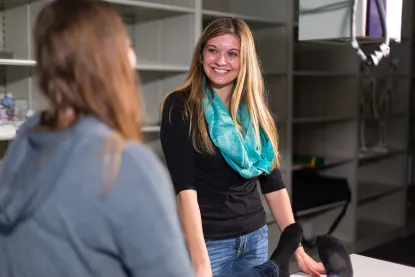
Clinical Experiences
A student will complete assigned clinical rotations each semester. Students will need transportation to attend clinical rotations.
- Semester 1 and 2: Advanced Center for Orthopedics, UPHS - Bell and UPHS - Marquette
- Semesters 3-5: Students may need to relocate for clinical internship during this time
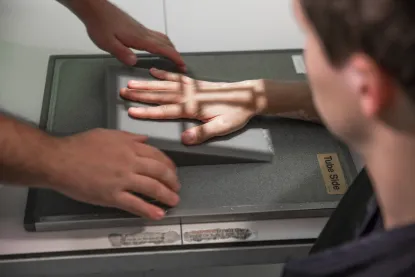
Program Faculty
Faculty members are highly credentialed, active in the profession of radiologic sciences, hold leadership positions in state organization and national honor societies, and published in prestigious journals. This combination of strong academic credentials and professional experience allows our faculty to guide our students through a meaningful learning experience that will prepare them for an entry-level role in diagnostic imaging.
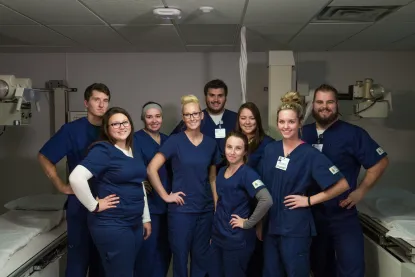
Program Accreditation
The Northern Michigan University (NMU) Radiography Program is accredited by the:
Joint Review Committee on Education in Radiologic Technology
20 North Wacker Drive, Suite 2850
Chicago, IL 60606-3182
312-704-5300
Email: mail@jrcert.org
The program’s current award is 8 years. General program accreditation information and the current
accreditation award letter can be found at https://www.jrcert.org/programs/northern-michigan-
university/
JRCERT Standard 6-Objective 6.1
The program maintains the following program effectiveness data:
- five-year average credentialing examination pass rate of not less than 75 percent at first attempt within six months of graduation,
- five-year average job placement rate of not less than 75 percent within twelve months of graduation, and
- annual program completion rate.
Application Policy
Northern Michigan University radiography program seeks to admit students who can provide evidence of potential to succeed in the health care profession of radiologic sciences. Applicants who meet all entrance criteria will be fully considered on an individual basis for admission.
The admission process is completed in four parts. An applicant must meet all application requirements/deadlines from Part I and Part II to participate in Part III. Admittance into the program is finalized by Part IV completion of proof of immunizations and a criminal background check. Student selection is based upon a point system for the following application criteria:
- Letter of introduction/intent
- Community service/healthcare experience
- Supportive course cumulative GPA
- Interview
The top 20 cumulative scores representative of a good academic standing, motivation, dedication, adaptability, good interpersonal skills, and a discernable interest in others will be accepted into the program. In the event there are two or more applicants with the same point total, the highest student overall GPA will be used to break the tie.
Admission Process: January 1 – April 1
Applying to the program
Prerequisite General Education Courses/Advisement Session
An applicant must:
1) Have the academic skills that will allow enrollment in college level general education courses such as College Composition and College Algebra. This may require testing through an Academic Skills Assessment Program (ASAP) administered by a college or university.
2) Complete all prerequisite general educational courses with a cumulative GPA of 2.5 or above by May 15 of the application year. A list of general education courses is located under Curriculum.
- College Composition II, Human Anatomy and Human Physiology must have a minimum grade of a C.
- Human Anatomy and Human Physiology must have been completed within a six-year period.
- A higher-level course may be substituted for MA 104, LB, CH 105, HL 101
Part II - Submission of application materials
An applicant must submit the following by April 1:
1) A completed official program application/attachments.
a. Letter of introduction/intent
i. Maximum 3 pages
1. Short autobiography (life experiences, aspirations, etc.)
2. Description of how you determine or evaluate your success
3. Example of when you gave up your personal time for a community or organization as a volunteer
4. Reasons for selecting radiography as a future career
5. Description of how you will benefit diagnostic imaging
2) Official transcripts of all college/university courses must be on file with the NMU registrar. (An official transcript must have been mailed directly from the institution).
3) Documentation of community service/healthcare experience form
Application Point Award Criteria
All applicants will be evaluated equitably according to the following point-award system. The highest-ranking applicants will be invited to participate in a personal interview with the Admission Committee
Letter of Introduction / Intent:
| Addressed topics | 0-0.25 point |
| Demonstrated insight | 0-0.25 point |
| Demonstration of personality | 0-0.25 point |
| Grammar | 0-0.25 point |
| Demonstration of interest in others | 0-0.25 point |
| 1.25 points maximum |
Community Service/Healthcare Experience
|
Health Occupations (4 points) Work experience with direct patient care > 1000 hours of experience |
Proof of Work Experience: (Note all information below must be included in the letter to receive points) Letter from current/former employee verifying employment. The letter must be on organizational letterhead with an original signature and must include applicant’s name, start date and end date (if applicable), employee status (full-time/part-time), number of hours worked per week (or total hours from/to date), job title, and examples of duties including type of patient interaction. Experience must be within the last 7 years. |
|
Previous Patient Care Experience (2 points) CNA, CMA, PCT, PCA, EMT |
Proof of patient care Experience: (Note all information below must be included in the letter to receive points) Requires certificate of completion indicating a formal training program and clinical experience but not necessarily a licensure or certification. (Ex. Certified Nurse Aide (CNA), Home Health Aide (HHA), Medical Assistant (CMA), Medication Aide, Patient Care Technician (PCT), or Patient Care Assistant (PCA), EMT or Paramedic, Phlebotomist, Psychiatric Technician, or Completion of at least 1 semester of a Vocational Nursing or Registered Nursing program with a grade of at least “C” in all courses. Must provide proof of certificate of completion. Experience must be within the last 7 years. |
|
Work/Volunteer experience (1 point) Credit for working while attending college (not health care related area) Minimum – work 16 hrs/wk with 6 credit hours
|
(Note ALL information must be included in the letter to receive the points) If you have maintained employment or volunteered at least 16 hours per week while attending college taking at least 6 credit hours, you may be eligible to receive additional points on the application. The letter from current/former employee verifying employment or volunteerism must be on organizational letterhead with an original signature and must include applicant’s name, start date and end date (if applicable), employee status (full-time/part-time), number of hours worked per week (or total hours from/to date), job title, and examples of duties including type of patient interaction. If self-employed, a notarized letter will be accepted. Experience must be within the last 7 years. |
|
Observation hours in Diagnostic Imaging (1-3 points) >100 hours 3 points 81-99 hours 2.5 points 60-80 hours 2 points 41-59 hours 1.5 points 30-40 hours 1 point |
Observation: Must include a letter from the institution or school detailing the # of hours completed, supervisor signature, and one page summary of activities. Observation must be in a hospital Diagnostic Imaging Department for full credit. You must have a minimum of 30 hours for points. Experience must be within the last 7 years. |
|
Observation hours in Health Care Facility Non-Diagnostic Imaging (1-2 points) Ex. HOSA or other school program > 40 Hours 2 points 20-39 Hours 1 point |
Observation: Must include a letter from the institution detailing the # of hours completed, supervisor signature, and one page summary of activities. Observation must be in a Health Care facility for full credit. You must have a minimum of 20 hours for points. (Ex HOSA) Experience must be within the last 7 years. |
|
Volunteer in health care (1-2 points) > 40 Hours 2 points 20-39 Hours 1 point |
Volunteer: Submit a letter on the institution or organization’s letterhead verifying volunteer service. The letter must include original signature and applicant’s name, start date and number of hours volunteered and examples of duties including type of patient interaction. Experience must be within the last 7 years. |
|
Community service or /Service Learning or Other volunteer activity (1 – 2 points) > 40 Hours 2 points 20-39 Hours 1 point |
Community Service: Documentation (letter of certificate) of participation in a community service to benefit a health care related organization or other service learning/volunteer activity. (Ex. American Heart Association, Hospice, Health Fairs, nursing home, YMCA,UPAWS, church activities) Experience must be within the last 7 years. |
|
RT Program – Clinical Experience (1-3 points) Minimum 200 documented hours RT Program – Courses Intro Courses or Program courses will be evaluated by the Program Director for additional points on application – must have completed at least 8 credit hours with a B or better. |
Previous Radiologic Technology Program Experience. For applicants previously admitted in the NMU or other RT program, applicant must submit a self-evaluation letter describing reasons for leaving the program, and what steps have been taken to ensure success if applicant is admitted to the NMU RT program. The Program Director must verify the number of clinical hours completed by providing a letter documenting attendance in program, number of clinical hours completed, and reasons for leaving the program early. Only students in Good Standing will be given additional points. Per the ARRT Code of Ethics, students who have been dismissed from a program due to Ethics violations such as patient safety/radiation safety, many not be eligible to be admitted into another program. Background and/or ARRT clearance may be required. For Rad Tech Course evaluation, a copy of transcripts from the institution must be included with the application for credit.*Applicant still must complete 16 credit hours at NMU. |
Part III - Supportive Course Cumulative GPA
Part IV - Admission Committee Interview
Application interviews will be conducted mid-May.
An applicant will be evaluated on the following criteria in their interview
| Knowledge of profession | 0-1 point |
| Dedication | 0-1 point |
| Managing change | 0-1 point |
| Accountability | 0-1 point |
| Interpersonal skills | 0-1 point |
| Total/3 interviewers | 15 points maximum |
Program Acceptance
Applicants will receive notification of their acceptance into the program by formal letter in May. Information in regards to program entrance status is mailed to the last address provided. It is the applicant’s responsibility to maintain current contact information. An applicant that cannot be reached will forfeit their position of acceptance.
Applicants who are not selected in the initial round are ranked highest to lowest according to their total award points and assigned alternate status. Alternates are offered enrollment in ranked order if a selected candidate declines admission or does not qualify based on health status or criminal background search. Alternate status terminates when the new school year begins in August. Those wishing to be considered for the following year must reapply. NMU radiography program does not maintain an applicant waiting list.
Health Status, Criminal Background Check, American Heart Association (AHA) Basic Life Support (BLS) for Healthcare Providers (CPR and AED) Certification, Drug Screen and Fingerprinting
Only those applicants accepted into the program complete Part IV of the admission process. This includes: immunizations, a criminal background check, AHA BLS certification, drug screen, and completion of the required forms of documentation. Select clinical affiliates may require fingerprinting.
Please be advised: The cost of immunizations, criminal background check, AHA BLS certification and drug screen is the responsibility of the student. (Healthcare services may be available at your local health department or university health center). The party responsible for the cost of the fingerprinting is determined by the clinical affiliate.
Enrollment into and graduation from the radiography program is contingent upon an accepted candidate’s demonstration of the health requirements listed below.
Health Status:
The following forms and supporting information are to be completed with authorized signatures.
1. Immunizations. Please provide documentation of your immunization record by completion of the School of Clinical Sciences immunization form.
a. Varicella, rubella and rubeola immunity
2. Hepatitis B. Please provide a copy of your Hepatitis B vaccination series completion or declination.
3. TB skin test to be completed after admission to the program. Please provide a copy of your TB skin test results.
4. Tetanus within the last 10 years.
5. Influenza immunization - to be completed in season no later than November 1.
All requirements are subject to change based on clinical affiliate requirements.
Criminal Background Check
For the protection of patients, employees and students, it is the policy of NMU to secure a criminal background check on all students if their clinical rotation exceeds 120 hours. Each student will complete and sign a disclosure/consent form. This completed form is to be returned to the program office with the School of Clinical Sciences immunization form by July 15. Criminal background checks will be completed at cost to the student.
Please be advised: Conviction of a crime may affect a student’s eligibility for licensure by the American Registry of Radiologic Technology (ARRT). Any student with a conviction record is advised to contact the American Registry of Radiologic Technologists at 615-687-0048 or at www.arrt.org in regards to their ability to complete the licensure registry examination upon completion of the program.
CPR/BLS Certification
For the protection of patients, employees, and students, it is the policy of NMU all students must successfully complete the American Heart Association (AHA) Basic Life Support (BLS) for Healthcare Providers (CPR and AED) Program. The American Red Cross Certification is not acceptable. A copy of your certification card must be provided by July 15. Certification will be completed at cost to the student.
Drug Screen
For the protection of patients, employees, and students, it is the policy of NMU all students must complete a drug screen through Occupational Medicine Services in Marquette. The drug screen will be completed at cost to the student.
Please be advised: Students demonstrating a positive drug test will be denied placement; however, they may have their application reconsidered for future admission to the Radiography Program at the Program Director’s discretion if clinical placement is available.
Upon change in clinical placement, additional requirements may need to be completed.
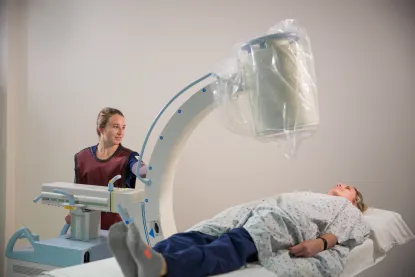
Take the Next Steps
For current NMU students:
- Review the steps on the application checklist
- Complete your radiography application
- Submit your additional materials
For future NMU students:
Contact Us
If you're not quite ready to apply and still have questions, we're ready to help:
Shaun O. Thunell, D.C., M.Ed, R.T.(R)(ARRT)
Northern Michigan University
Associate Dean/Director School of Clinical Sciences
Radiography Program Director
Associate Professor
Office: The Science Building 3513
Phone: 906-227-2868
Email: sthunell@nmu.edu
The Radiography Profession
What is a radiographer?
A radiographer is an allied health professional that uses ionizing radiation (x-rays) to produce images of the internal structures of the human body. A radiologist (doctor who specializes in the interpretation and diagnosis of disease or injury) views these images. A radiographer assists the radiologist with many procedures including positioning the patient, administering contrast agents, operation of diagnostic imaging equipment, image processing, radiation exposure factors and radiation protection. Computer and digital equipment are utilized. A radiographer must have good interpersonal skills to deal with patients and health care workers. With additional education, a diagnostic imager may perform more specialized imaging procedures further assisting in the diagnosis of disease.
What is the career outlook and average income for radiographers?
The field of diagnostic imaging has advanced significantly over the past two decades with its introduction of new equipment and imaging modalities. Skilled diagnostic imagers are in demand throughout the United States and the world, with career opportunities in hospitals, private practices, education, product development, technical sales and research. Radiographers with experience and additional education may go on to perform advanced imaging procedures such as CT, MRI, and mammography will have the best employment opportunity.
Advancements: Radiographers may be promoted to supervisor, chief technologist, or department administrator or director. Some radiographers advance by specializing in the occupation to become instructors or directors in radiologic technology educational programs. Others may be employed as sales representatives or instructors with equipment manufacturers.
Job Outlook: According to the U.S. Bureau of Labor Statistics, radiologic technologists held about 250,000 jobs in 2018, and more than half work in hospitals. A number of new jobs are found in offices of physicians and diagnostic imaging centers. Employment is projected to grow 9 percent from 2018 to 2028, faster than the average for all occupations. As the population grows older, there will be an increase in medical conditions that require imaging as a tool for making diagnoses.
Demand for radiographers tends to be regional with some areas having large demand, while other areas are saturated. Radiographers willing to relocate may have a better job prospect.
Earnings: A graduate from NMU’s program as an entry-level radiographer averages $18/hour to $23/hour as a starting wage in our geographic area. According to the U.S. Bureau of Labor Statistics the median annual wage for radiologic technologists was $60,510 in May 2019.
What sort of work environment does a radiographer have?
Physical stamina is required in this occupation. Radiographers are on their feet for long periods of time, may be required to lift or position their patients and may have to perform radiographic procedures at a patient’s bedside. Although radiation is used in this profession, the use of lead aprons, gloves and other shielding devices minimize this exposure. Radiographers wear radiation-monitoring devices to measure and record levels of occupational radiation exposures.
Radiographers should be sensitive to a patient’s physical and psychological needs. They must pay attention to detail, follow instructions and work as part of a team. Radiographers must also operate complicated imaging equipment, which requires mechanical ability and manual dexterity.
Most full-time radiographers work about 40 hours per week. This may include evening, weekend or on-call hours. Some radiographers work part-time for more than one employer.
Where can I find additional information on the radiography profession?
Information on careers in radiologic technology, contact:
American Society of Radiologic Technology
15000 Central Ave, SE, Albuquerque, NM 87123.
http://www.asrt.org
For the current list of accredited education programs in radiography, contact:
Joint Review Committee on Education in Radiologic Technology
20 Wacker Drive, Suite 2850, Chicago, IL 60606-3182.
http://www.jrcert.org
For certification information, contact:
American Registry of Radiologic Technologists
1255 Northland Dr, St. Paul, MN 55120-1155.
http://www.arrt.org
Frequently Asked Questions
Does UPHS - Marquette still operate the radiography program?
How difficult is it to be accepted into the program?
Why do you limit your enrollment into your program?
A limited capacity provides students from a broad range of ability levels a one-on-one learning environment of guidance and feedback. Each two-week clinical rotation will have one student at a time to allow the student enough opportunity to reach competency in procedures performed in that clinical rotation.
What do you look for when evaluating your application candidates?
The Admissions Committee looks for individuals who have a strong academic background in biological sciences and communication. This can be demonstrated through high school and college-level course work and service-oriented work experience. Applicants must possess good interpersonal communication skills and a discernable interest in others.
How can I enhance my chances of being selected?
The Admissions Committee will not guarantee acceptance to any candidate. The ideal candidate:
- is knowledgeable in the field of medical imaging sciences – radiography
- has work experience with the public
- communicates well verbally and in writing
- possesses a positive attitude, caring demeanor and strong work ethic
- has a proven record of academic success
Are college programs better than a hospital-based program?
Will I be able to replace courses in the program with previously completed courses (ie. anatomy, algebra, physics, etc.)?
When I am listed as a Pre-RAD student at NMU does this mean I have been accepted into the Radiography Program?
Will I be able to work full-time while attending this program?
It is for each individual to honestly evaluate their abilities and determine if after the full-time commitment necessary to complete the program the individual can handle the added responsibility of full-time employment and maintain the performance standards expected by the program. The radiography program cannot dictate what a student does outside of the program, but past student experiences have demonstrated extreme difficulty for the student to successfully meet the requirements of both.
What are my options if I do not get accepted into the radiography program?
Can I complete some of the RAD courses while taking the general education courses or while I am waiting to re-apply?
Is diagnostic imaging safe to work in? Do you receive a large dose of radiation working in this profession?
Diagnostic imaging is considered a safe working environment. Most of the procedures do not require a radiographer to be in the room when radiation is being used for image production. When an imager has to be in the room with the patient (during fluoroscopy) protective apparel, protection devices, radiation monitors and radiation safety practices are employed.
Does NMU provide job placement after graduation?
NMU will not provide job placement upon program completion. A student may seek assistance in resume writing, interview procedures and job listings through the NMU Career Center. A student may review career outlook, work environment, earnings and job placement for previous graduates in the medical imaging sciences and standards and outcome sections of the website.
Is NMU's program accredited?
Yes.
The Northern Michigan University (NMU) Radiography Program is accredited by the
Joint Review Committee on Education in Radiologic Technology
20 North Wacker Drive, Suite 2850
Chicago, IL 60606-3182
312-704-5300
Email: mail@jrcert.org
The program’s current award is 8 years. General program accreditation information and the current
accreditation award letter can be found at https://www.jrcert.org/programs/northern-michigan-
university/
Standard 6-Objective 6.1The program maintains the following program effectiveness data:
- five-year average credentialing examination pass rate of not less than 75 percent at first attempt within six months of graduation,
- five-year average job placement rate of not less than 75 percent within twelve months of graduation, and
- annual program completion rate.
JRCERT Program Effectiveness Data Definitions
